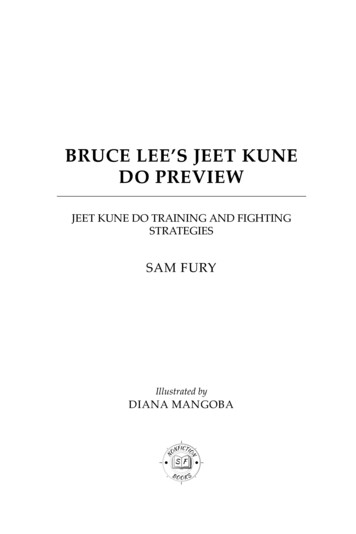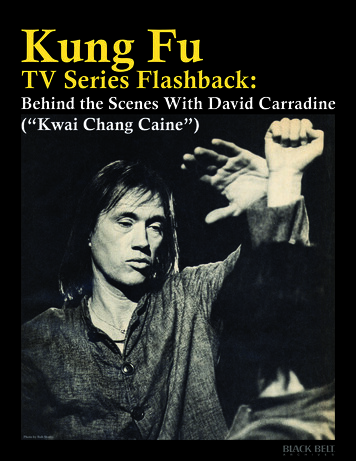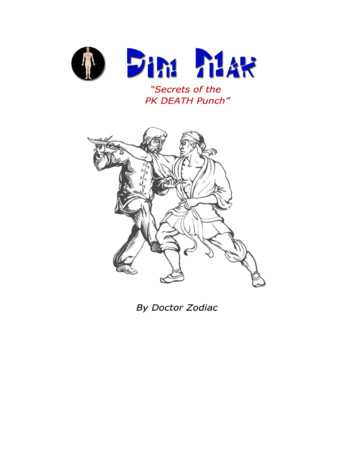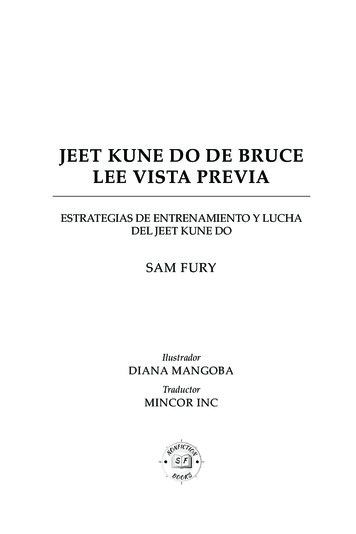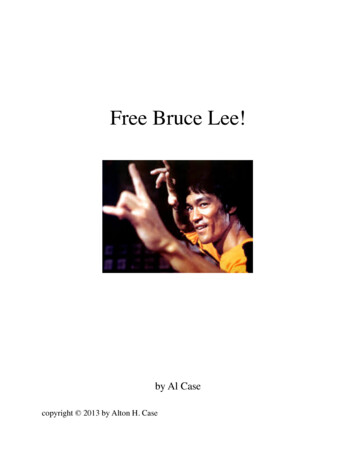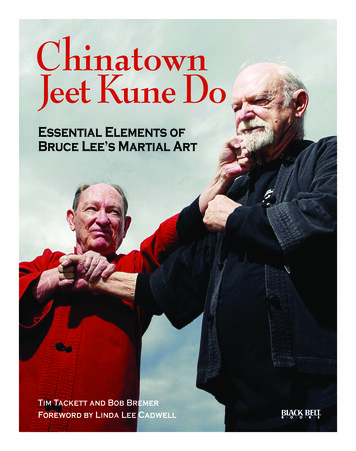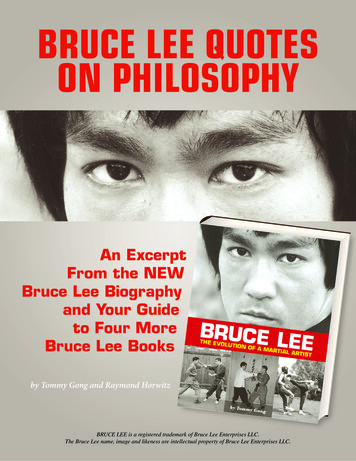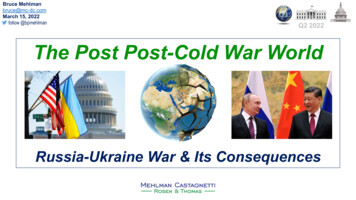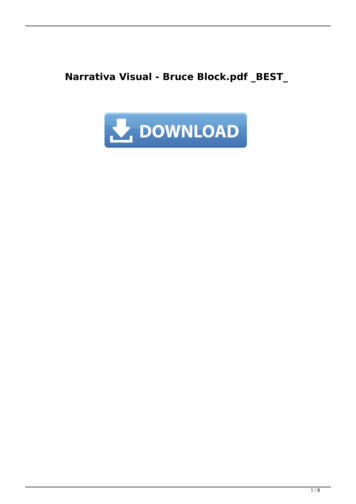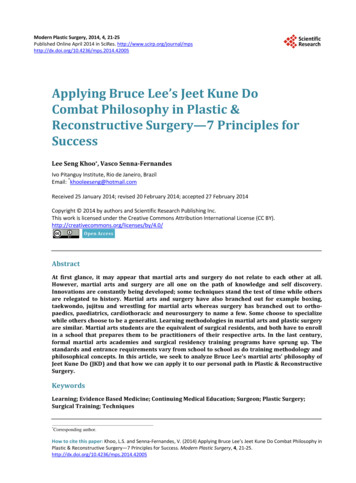
Transcription
Modern Plastic Surgery, 2014, 4, 21-25Published Online April 2014 in SciRes. 10.4236/mps.2014.42005Applying Bruce Lee’s Jeet Kune DoCombat Philosophy in Plastic &Reconstructive Surgery—7 Principles forSuccessLee Seng Khoo*, Vasco Senna-FernandesIvo Pitanguy Institute, Rio de Janeiro, BrazilEmail: *khooleeseng@hotmail.comReceived 25 January 2014; revised 20 February 2014; accepted 27 February 2014Copyright 2014 by authors and Scientific Research Publishing Inc.This work is licensed under the Creative Commons Attribution International License (CC tractAt first glance, it may appear that martial arts and surgery do not relate to each other at all.However, martial arts and surgery are all one on the path of knowledge and self discovery.Innovations are constantly being developed; some techniques stand the test of time while othersare relegated to history. Martial arts and surgery have also branched out for example boxing,taekwondo, jujitsu and wrestling for martial arts whereas surgery has branched out to orthopaedics, paediatrics, cardiothoracic and neurosurgery to name a few. Some choose to specializewhile others choose to be a generalist. Learning methodologies in martial arts and plastic surgeryare similar. Martial arts students are the equivalent of surgical residents, and both have to enrollin a school that prepares them to be practitioners of their respective arts. In the last century,formal martial arts academies and surgical residency training programs have sprung up. Thestandards and entrance requirements vary from school to school as do training methodology andphilosophical concepts. In this article, we seek to analyze Bruce Lee’s martial arts’ philosophy ofJeet Kune Do (JKD) and that how we can apply it to our personal path in Plastic & ReconstructiveSurgery.KeywordsLearning; Evidence Based Medicine; Continuing Medical Education; Surgeon; Plastic Surgery;Surgical Training; Techniques*Corresponding author.How to cite this paper: Khoo, L.S. and Senna-Fernandes, V. (2014) Applying Bruce Lee’s Jeet Kune Do Combat Philosophy inPlastic & Reconstructive Surgery—7 Principles for Success. Modern Plastic Surgery, 4, 21-25.http://dx.doi.org/10.4236/mps.2014.42005
L. S. Khoo, V. Senna-Fernandes1. IntroductionJeet Kune Do (JKD) literally translated from Chinese means “way of the intercepting fist”. It reflects BruceLee’s concepts, philosophy and training methods with regards to martial arts [1]. Bruce Lee who started his basewith Wing Chun Kung Fu eventually rejected the notion of sticking to one art and began exploring various othermartial arts styles including boxing, judo, wrestling, savate and fencing [1]. Bruce Lee disposed with idealswithin a style adopting a flexible approach to seek what works best. He christened his martial art as Jeet KuneDo [1].Bruce Lee (1940-1973) is a world renowned martial artist, filmmaker and philosopher [2]. He broke boundaries of cross training and applying modern training methods in martial arts. However Bruce’s philosophy ofcombat which is applicable to both martial arts and plastic & reconstructive surgery stands out.2. MethodsLiterature review of all Bruce Lee’s combat philosophy work was carried out. Direct quotes and written materialof Bruce Lee were noted from the publications available including interviews and books. The philosophicalconcepts of Bruce Lee were analyzed and 7 of the most important ones applicable to plastic surgical practicewere selected. These 7 concepts were expanded upon with direct examples of how it may help plastic surgeonsin their practice. The concepts were applied to learning methodology, character development and appropriatetechnical refinement.3. Bruce Lee’s Combat Philosophies and Application in Plastic Surgery3.1. Empty Your CupOne of Bruce’s favorite parables was the story of the western scholar who came to Japan to learn about Zenfrom an old Zen master [3]. As the story goes, the two sat down to introductory tea, and it became evident a thatthe western scholar was more interested in telling the Zen master what he knew than learning anything from him.As the Zen master poured the tea for his guest, the scholar continued to ramble on. The tea began to spill overthe edges of the cup; the Zen master continued pouring. “Sir!” said the western scholar. “The cup is over-full!”“Yes,” replied the Zen master, “and like this cup you too are over-filled with your own ideas and opinions.How do you expect to learn if you are not willing to empty your cup?”Bruce encouraged his students to speak up if they had a difference of opinion in his teachings but, if pushedtoo long, he would say, “At least empty your cup and try” [3]. Bruce believed that you should not dismisssomething out of hand without first investigating it yourself.As surgeons; we are often biased in our beliefs and we reject a new paradigm of thought or new method inlieu of what we feel comfortable in performing or how we were trained during residency. Granted, we may beright. However, we should acknowledge that other methods may work and the surgeons who adopt them musthave had reasonable logic to adopt them. Their beliefs may be as valid as ours. By trying it first hand, we maychoose to either accept or reject or even improvise. We cannot learn something new if we do not empty our cup.3.2. Be Like WaterLike live combat, nothing is certain and we must adapt to circumstances. Lee felt that you need to be able toadapt to any situation that you may encounter and relates it to being like water, “Empty your mind, be formless,shapeless, like water. If you put water into a cup, it becomes the cup. You put water into a bottle and it becomesthe bottle. You put it in a teapot it becomes the teapot. That water can flow, or it can crash. Be water my friend”[4].Real life surgery is not neatly presented like those in operative surgical atlases. Anatomical variances maythrow us in a state of panic. The perforator we marked out for microsurgery may not be found or the vessels maybe unsuitable for anastomosis. If we do not adopt and improvise; the surgery will at best yield mediocre results.Having the ability to think quick on one’s feet are all essential tools for the surgeon. As plastic surgeons, we receive many referrals for example secondary rhinoplasty cases where the underlying anatomy and availability ofgrafts are anyone’s guess. There may be a lack of donor cartilage and the internal architecture may have beendistorted. In such situations, we must be like water, adapting ourselves modifying the plan and moving ahead22
L. S. Khoo, V. Senna-Fernandeswith the task at hand.3.3. Seek to Understand the Root“What we are after is the root not the branches. The root is the real knowledge; the branches are surface knowledge” [5].Very often we get caught up in the latest weekend facelift technique or an attractive laser or IPL (IntensePulsed Light) machine. When we dig further we realize that the revolutionary “new” weekend lift is not “new”by any means. Conservative facelift via minimal incision with purse string sutures was first described in 1927 byGaston Doit et Cie in Paris [6]. These small lifts may work well for younger patients but for older patients; thesedesigner weekend lifts may not produce long lasting results.We have a myriad of complex laser modalities available for our use today. While this is not necessarily a badthing; we need to return to roots to understand which chromophores and wavelengths are appropriate. Basic laser physics understanding are paramount to carrying out safe and effective laser surgery. Knowing the ThermalRelaxation Time (TRT) and ideal pulse width/duration are more important than simply purchasing and utilizingthe latest laser equipment. Many surgeons get caught up with the hype and rely on manufacturing representatives to “train” them on the product neglecting their own need to study the basics of laser physics for optimal useof lasers.3.4. An Intelligent Mind Is Constantly Learning“An intelligent mind is constantly learning, never concluding—styles and patterns have come to conclusion,therefore they have ceased to be intelligent” [5].A plastic surgeon should always strive to keep oneself in the forefront of knowledge by formal study, personal experience and by attending Continuing Medical Education (CME) courses and congresses. What we learnt asthe “truth” yesterday may no longer hold true todayFor example, in the past punch grafting of the hair was the accepted standard of care in hair restoration surgery. This gave rise to a pluggy look but by industry standards these were all reasonably acceptable results backthen. Today this technique has been superseded by the strip method of donor harvesting and also Follicular UnitExtraction (FUE) giving rise to natural looking hair transplants [7].To offer our patients the best plastic surgery treatments available; we should seek to apply Evidence BasedMedicine (EBM) i.e., evidence based plastic surgery. Keeping up to date by perusing journals and learning fromfellow colleagues allow us to continue practicing at a high level.3.5. Absorbing What Is UsefulOnly through learning a combat system will an artist be able to, “absorb what is useful”, and discard the remainder “-honestly expressing oneself” [3]. Real combat training situations such as full contact sparring andMixed Martial Arts (MMA) competitions allow the student to learn what works, and what doesn’t. The definingpoint of this principle is that the choice of what to keep is based on personal experimentation. If the technique isnot beneficial, it is discarded. Lee believed that only the individual could come to understand what worked forhimself [3] [5].In the field of Plastic Surgery, we will undoubtedly be exposed to various colleagues each with their own wayof performing a surgery. It is important we learn what made them successful and also less successful. By absorbing good techniques that give good results, we absorb the useful. Techniques that do not work well for us,we discard. We may also add what is specifically our own giving it a twist or flavor (“honestly expressing oneself”).3.6. Economy of MotionBruce Lee advocated that every movement must be purposeful. Efficiency, directness and simplicity are thehallmark of Jeet Kune Do [1].Economy of motion is the principle by which JKD practitioners achieve:Efficiency: An attack which reaches its target in the least amount of time, with maximum force.Directness: Doing what comes naturally in a disciplined way.23
L. S. Khoo, V. Senna-FernandesSimplicity: Thinking in an uncomplicated manner; without ornamentation [1].Each surgical procedure can be broken down into components of instruments and movements of the body required to complete each task. If the number of instruments and the passage between surgeon and assistant can bereduced, the time required to complete an operation will be drastically shortened. If the body is ergonomicallypositioned, movements will be efficient and less tiring.It is the responsibility of the surgeon to utilize the instrument handed till the task at hand is done to completion reducing the needless passing back and forth of the instrument which inevitably increases operating time.(Efficiency)Surgical assistants should be trained to perform certain parts of the operation and not just confined to retracting and cutting sutures. This benefits the assistants and they would be in a more ergonomic position to carry outcertain portions of surgery. Avoiding the needless change of surgeon position minimizes fatigue and time wastage. (Directness)A thorough knowledge of anatomy allows the surgeon to enter the surgical terrain with confidence. This eliminates the need for stumbling or getting stuck in a step. To quote Bruce Lee “It’s not the daily increase butdaily decrease. Hack away at the unessential” [3]. Surgical speed is reduced by reducing the redundant steps.(Simplicity)3.7. Be Humble“To be humble to superiors is duty; to equals is courtesy; to inferiors is nobleness; and to all safety” [3] [5].If we cultivate a nasty overbearing attitude and mistreat any colleague be it equal or junior; this breeds an unhealthy work environment. Many surgical misadventures happen due to misunderstanding and staff who will notspeak up in lieu of any surgical steps overlooked or missed. A classic example was a surgeon who removed awrong kidney [8]. He was alerted by a medical student watching the operation but dismissed the student withoutbothering to recheck the surgical site [9].Such mishaps are always avoidable. A surgeon should always be courteous so as to gain trust and camaderieof surgical staff and fellow colleagues—being approachable yet commanding authority.4. ConclusionsBruce Lee transcended martial arts, action films and philosophy. His philosophy is applicable to many facets oflife and even in our realm of plastic and reconstructive surgery. Bruce has influenced generations since hispassing with his concepts of liberation from classical thought, bending to adversity, economy of action, andopenness to learning. These are philosophical concepts that can and will benefit many plastic and reconstructivesurgeons.“Knowing is not enough, we must apply. Willing is not enough, we must do.” Bruce Lee [3].Conflict of InterestsThe authors have no conflict of interests to declare.References[1]Lee, B. (1975) Tao of Jeet Kune Do. Ohara Publications, Burbank.[2]Little, J. (2001) Bruce Lee: Artist of Life. Tuttle Publishing, North Clarendon.[3]Little, J. (1996) The Warrior Within: The Philosophies of Bruce Lee to Better Understand the World around You andAchieve a Rewarding Life. McGraw-Hill, New York.[4]Lee, B. (1966) Pierre Barton Show. Pierre Barton, Hong Kong.[5]Little, J. (2002) Striking Thoughts: Bruce Lee’s Wisdom for Daily Living. Tuttle Publishing, North Clarendon.[6]Virenque, M. (1927) Traitement chirugicale des rides de la face et du cou. In: Pauchet, V., Ed., La Pratique Chirugicale Ilustree, Gaston Don et Cie, Paris.[7]Unger, W. and Unger, M. (2009) The Atlas of Cosmetic Surgery. Kaminer, A., et al., Eds., 2nd Edition, Elsevier,London, Chapter 22, 365-398.[8]Dyer, O. (2014) Urologists Cleared of Manslaughter Now Face 50318/24
[9]L. S. Khoo, V. Senna-FernandesYou’re Taking Out Wrong Kidney, Surgeon Was Told 3005/Youre-taking-wrong-kidney-surgeon-told.html25
concepts of Bruce Lee were analyzed and 7 of the most important ones applicable to plastic surgical practice were selected. These 7 concepts were expanded upon with direct examples of how it may help plastic surgeons in their practice. The concepts were applied to learning methodology, character development and appropriate technical refinement. 3. Bruce Lee's Combat Philosophies and Application in Plastic Surgery 3.1. Empty Your Cup

